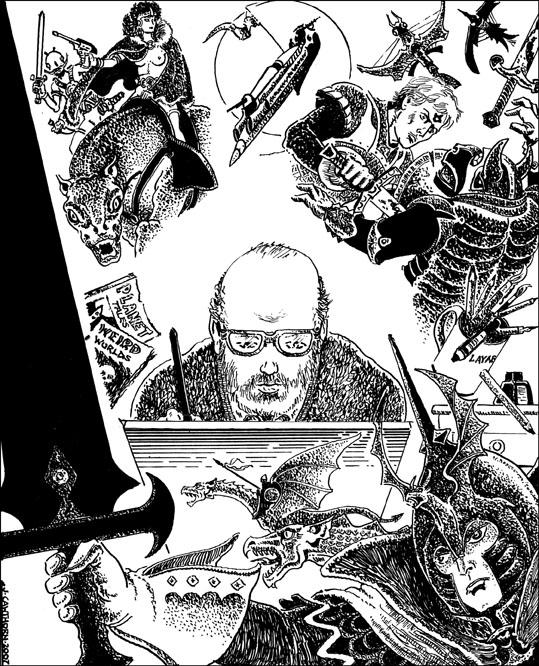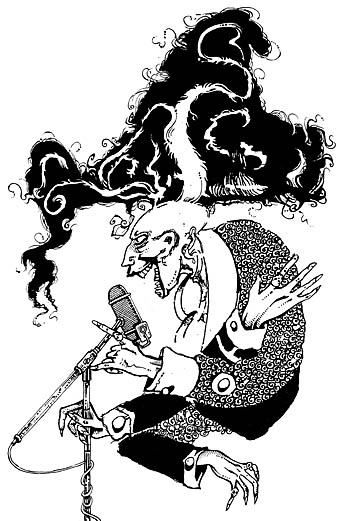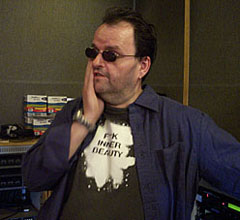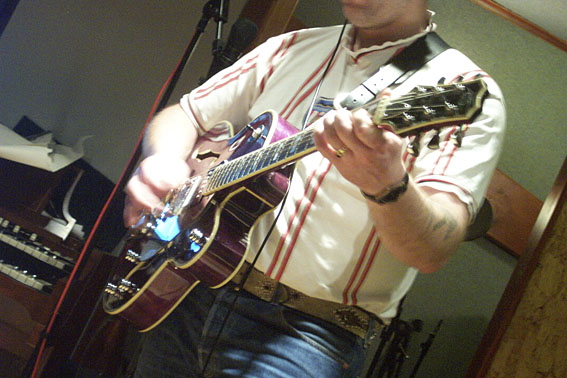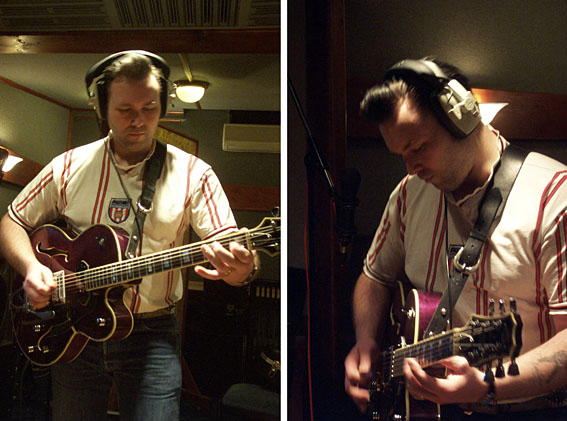| HOME | BOOKS | COMICS | RECORDS | NEWS | PEOPLE | PICTURES | ORDERS | HISTORY | office@savoy.abel.co.uk |
| S E P T E M B E R 2 0 0 7 • • • James Cawthorn, England's Greatest Living Fantasy Artist
Innovative artist James Cawthorn was the stella light in Savoy's first round of publication, with his graphic adaptation of Michael Moorcock's Stormbringer, back in 1976. In 1977 he drew a new set of illustrations for Savoy's second book, Sojan, a reprinting of Michael Moorcock's original fantasy stories from Tarzan Adventures (1957/58). Since then a thirty-year collaboration between Cawthorn and Savoy has been sustained, one that included the first British graphic novel, The Jewel in the Skull (1978), with its stunning collection of double-page illustrations, and later The Crystal and the Amulet (1986). The third and final title in the series awaits a schedule. Jim has illustrated many books for Savoy over the years, including Henry Treece's Celtic Quartet (1980) and Maurice Richardson's The Exploits of Engelbrecht (2000). Thirty-eight of his early original artworks, thrilling and radical as first-generation rock'n'roll, were collected in Jon Farmer's Sieg Heil Iconographers (2006). He is currently at work on his adaptation of Edgar Rice Burroughs' A Princess of Mars, fulfilling a lifelong ambition.
Jim's self-portrait, a small nod to his continuing work with Savoy, drawn July 2007. |
| J U N E 2 0 0 7 • • • Horror Panegyric left: Lord Horror by Britton/Guidio. A forthcoming book from Savoy by K Seward, an author new to us, this is a more than worthy addition to our list, delivering a critique from an American perspective. Horror Panegyric casts a new critical light on the Lord Horror canon and picks up on a number of points that have not been raised by other critics. K Seward, an incisive art critic, is an expert on William Burroughs, and a man with his ear cocked firmly in the direction of the literary perverse. For followers of all things Savoy, this will be a gem of a book. Albeit compact, and not in the realms of recent large self-critical works from the Savoy press, it will nevertheless be one that punches beyond its weight. Below, we have some tasty extracts to give readers a flavour. Horror Panegyric, a deluxe hardback, will draw for its inspiration on Grove Press's promotional booklet to accompany the November 20th 1962 American publication of Naked Lunch. Clearly, Barney Rosset, Grove's owner, printed the prospectus with an obscenity trial in mind; the entire document reads like a legal argument to establish Naked Lunch's literary merit before a courtroom. It might be said that our own battles with the censor are safely in the past, but the effects of the censorship attempts are not. The Lord Horror novels are blanked by the English literary press, stigmatised into silence, and there is no guarantee that the two-headed snake will not attack again as times change and new laws on what constitute present-day obscenity (racial or paedophilic) appear. It is hoped that Horror Panegyric will serve both to deter attacks and alter the perceived perception of the Lord Horror canon. Seward's book will contain a detailed Lord Horror 'timeline' as well as selected extracts from the three novels, Lord Horror, Motherfuckers: The Auschwitz of Oz and Baptised in the Blood of Millions. "My guess is that your work is simply going to follow the same route as authors like Ballard or Philip K Dick—they start out as 'genre' authors, but then readers gradually realise that the books transcend those genres." K Seward to Michael Butterworth, 29/1/07 "I view Burroughs much like a shark. He needed constant movement and unlimited creative sustenance." Jed Birmingham ('Burroughs, Berrigan and The Ticket That Exploded', Realitystudio.org website) Extracts from Horror Panegyric by K Seward
|
| • • • Kris Guidio: The new montage photo-shoot!
Kris Guidio, whacky artist-maestro of British comics, dons a clever persona, a one-man happy party, to celebrate putting ink on the final illustrations for La Squab: The Black Rose of Auschwitz, the fourth Lord Horror novel. Now complete, the book will be published late 2008.
|
| • • • Fenella Keeps Rocking
Stephen Boyce-Buckley at the controls (photo by Andrew Price). The gang congregated at Gracielands on 16th May 2007 to make further progress on the Fenella Fielding tracks. Under the spotlight that day were the brass section from Bury's Well Said, putting tremendous riffing saxes and trombone on 'The Animal In Me'. Under the musical direction of Andrew Price, members from the BBC Philharmonic added Bollywood strings to 'Angels' and 'Can't get You Out of My Head'. Right on the button Jackie Reid, fresh from performing with Heather Small, sang R&B soul on 'The Snake' and 'Angels'. Photos by Michael Butterworth unless otherwise credited.
Jackie Reid.
Darren McLean (baritone sax), Gareth Hodge (trombone), Martin Entwhistle (tenor sax).
Andrew Price.
Clockwise from centre: Andrew Price (violin), Clare Dixon (violin), Martin Wallington (viola), Peter Dixon (cello), Steve B-B.
Peter Dixon.
Producer John Scott (photo by Andrew Price). |
| M A Y 2 0 0 7 • • • The Fenella Fielding Sessions, cont. Savoy supremos David Britton and Michael Butterworth gathered again at the Gracieland Studios, Rochdale on 26th April to begin final recording and mixing of the forthcoming Fenella Fielding: The Savoy Sessions CD. With them were producer-in-chief Stephen Boyce Buckley, young blood Alex 'Fizzy Trance' and assorted brigands. Photos by Michael Butterworth.
Jon Farmer (above), author of Sieg Heil Iconographers, the latest book from Savoy. One of the finest people to come to us in 20 years. A walking encyclopaedia of pop culture. No pantomime, media-slick man, Jon's pure rockabilly and full strength raw bottle, and all the better for it.
Darrel Higham, the Mr Big of English Rock'n'Roll. The best rock'n'roll singer/guitarist in the business. If Eddie Cochran had a son, he'd sound like this.
Darrel's corrosive guitar puts the stamp of real rock'n'roll on these Fenella Fielding recordings. His mighty riff for 'What'd I Say' opens New Order's 'Blue Monday' in a manner that will have Ian whirling dervishly in his mausoleum once again.
A bone-splitting guitar solo on 'Rusty Cage' had us all spellbound in the studio and he put enough whammy twang on 'Big in Japan' to kill Radiohead. All aboard the Higham Experience to Surreal City! Adding to the atmosphere of this most Manchester rock'n'roll party were the studio's own Martin, Phil and Tim, who kept the usual elegant and tight ship. As last year, the sun shone benevolently into the gardens of the La Stansfield family and the primrose blooms fell in a blossom shroud on all of us in The Last Rock'n'Roll Redoubt. |
| Earlier news |
| Main News Page | New Books | New Comics | New CDs | Ongoing Projects |
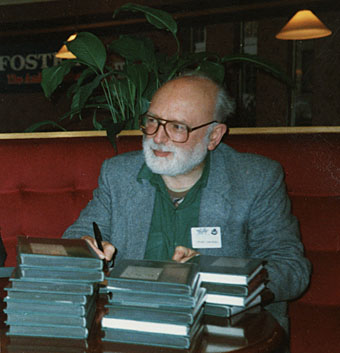 left: Michael Moorcock's favourite illustrator at the signing for A Hundred Best Fantasy Books (1987), Cawthorn's seminal review of the essential works in the field.
left: Michael Moorcock's favourite illustrator at the signing for A Hundred Best Fantasy Books (1987), Cawthorn's seminal review of the essential works in the field.